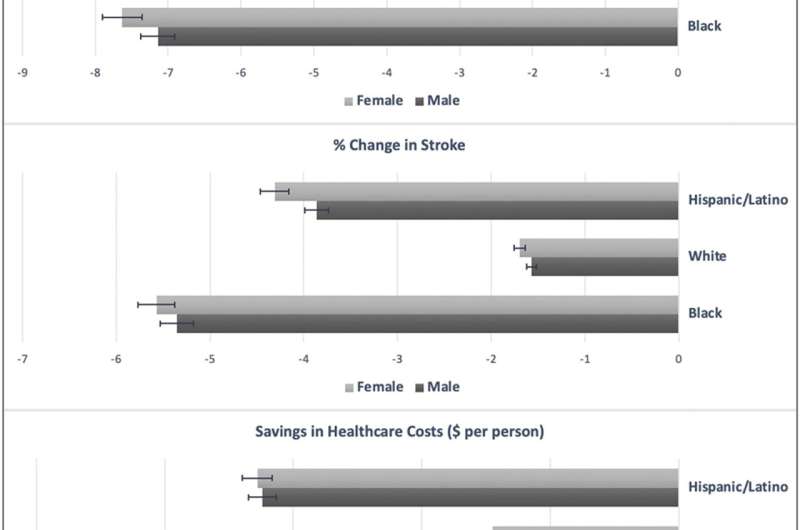This article has been reviewed according to Science X's editorial process and policies. Editors have highlighted the following attributes while ensuring the content's credibility:
fact-checked
peer-reviewed publication
trusted source
proofread
Home blood pressure monitoring saves lives, cuts costs, and reduces healthcare disparities

Expanding home blood pressure monitoring among US adults with hypertension could substantially reduce the burden of cardiovascular disease and save healthcare costs in the long term, according to a new study in the American Journal of Preventive Medicine. The results of the study show that expanding home monitoring has the potential to address pervasive health disparities facing racial and ethnic minorities and rural residents because it would reduce cardiovascular events among US adults.
Co-lead investigator Yan Li, Ph.D., Professor, School of Public Health, Shanghai Jiao Tong University School of Medicine, explained, "Our study is among the first to assess the potential health and economic impact of adopting home blood pressure monitoring among American adults with hypertension. We found that it facilitates early detection, timely intervention, and prevention of complications, leading to improved control and better health outcomes."
Analyzing data from the 2019 Behavioral Risk Factor Surveillance System (BRFSS), investigators projected that implementing home blood pressure monitoring, as opposed to traditional clinic-based care, could result in a reduction of myocardial infarction (MI) cases by 4.9% and stroke cases by 3.8% over 20 years.
Non-Hispanic Blacks, women, and rural residents had more averted cardiovascular events and greater cost savings related to adopting home blood pressure monitoring compared to non-Hispanic Whites, men, and urban residents.
Adopting home blood pressure monitoring in rural areas would lead to a potential reduction of 21,278 MI cases per one million people compared to 11,012 MI cases per one million people in urban areas. Rural residents tend to have a higher prevalence of hypertension and uncontrolled hypertension than urban residents and often face additional barriers in accessing primary care services.
Estimating healthcare cost parameters based on actual healthcare payment data from the Medical Expenditure Panel Survey (MEPS), researchers projected an average of 4.4% per person annual savings and an average of $7,794 in healthcare costs per person over a span of 20 years in this population due to home blood pressure monitoring adoption and the subsequent reduced cardiovascular disease cases.
Previous economic evaluations of home blood pressure monitoring have primarily focused on local health systems or conducted short-term, small-scale randomized controlled trials.
Hypertension—systolic blood pressure (BP) greater than 130 mmHg or a diastolic BP greater than 80 mmHg or being on medication for it—is a pressing public health challenge in the US, with significant implications for the development of heart disease and stroke and leads to substantial healthcare costs.
Traditional clinic monitoring, the common method for BP measurement and hypertension diagnosis, has a number of drawbacks: Patients may not visit clinics often enough to pick up the problem, and when they do, accuracy may be compromised by the "white coat" (high office BP but normal BP on home measurements) or "masked" (normal/high normal BP in the office but elevated at home) effects.
Home blood pressure monitoring eliminates these impediments and provides more comprehensive and accurate data compared to sporadic measurements obtained during clinic visits. Yet, the highly effective practice has not been widely adopted in the US because of inadequate health insurance coverage, lack of investment in preventive services, and limited health promotion efforts provided by primary care physicians.
However, the landscape has changed between 2020 and 2022 when home blood pressure monitoring attracted increasing attention due to healthcare disruptions caused by the COVID-19 pandemic.
Co-lead investigator Donglan Zhang, Ph.D., Associate Professor, Center for Population Health and Health Services Research, New York University Long Island School of Medicine, commented, "Given that almost half of all adults in the US (47%) are affected by high blood pressure, and considering the persistent health disparities in cardiovascular health, it is very important to advocate for the widespread adoption of effective and cost-saving strategies."
"Home blood pressure monitoring empowers patients to take a more active role in managing their chronic conditions. Our findings provide compelling evidence for healthcare systems and payers supporting the broader implementation of this intervention."
More information: Yan Li et al, The Health and Economic Impact of Expanding Home Blood Pressure Monitoring, American Journal of Preventive Medicine (2023). DOI: 10.1016/j.amepre.2023.05.010


















